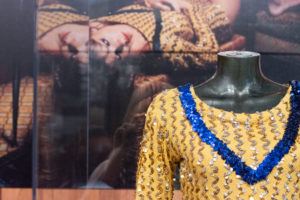“Music and visual art, two distinct expressions of human creativity, often intertwine in fascinating ways.”

POV provides AMA friends and fans the opportunity to share their knowledge and point of views about art. This POV was submitted by guest contributor Nathan Boschult, practitioner and spokesman for Texas Real Estate Source. He is a graduate of the University of Texas at Austin. Featured image from one of the AMA’s current exhibits, Taylor Swift | The Eras Tour Collection.
![]()
Music and visual art, two distinct expressions of human creativity, often intertwine in fascinating ways. Both share universal languages, transcending barriers to touch hearts and stimulate minds. Some artists dabble in music; some musicians fancy themselves artists. Some intrepid creatives even combine the two.
An exploration of the symbiotic relationship between art and music is a worthwhile pursuit for any artist, not to mention anyone who appreciates them. How do they influence each other? How can they combine for a multi-sensory experience? How has the evolution of visual art been impacted by music (and vice versa)? By analyzing historical cross-pollination and contemporary collaborations, we delve into how music and visual art shape, reflect, and challenge societal perspectives.


How Do We Define Art?
Art is not solely defined by its content; rather, the emotions it incites and the meanings it conveys to the beholder contribute significantly to a work’s classification as art. Even when designing your dream home, you’re considering far more than simply the physical construction of the home. Many factors come into play, and countless influences contribute to the final outcome. Similarly, art is a dynamic and intimate communication conduit, allowing us to articulate thoughts, sentiments, instincts, and aspirations in a way that words simply cannot replicate. When we engage in artistic creation, our selected medium becomes the messenger of our intent, facilitating our self-expression and ideas. The substance of our art is crucial, but the manner of its presentation truly characterizes it.
Music has always wielded a profound influence over visual arts. Artists frequently draw inspiration from the harmonies and rhythms they perceive, transposing these onto their artistic mediums. This blend of music and visual arts yields a multi-sensory encounter for both the creator and the observer. Essentially, art serves as a direct transmutation of music onto canvas or any chosen medium, capturing not only auditory elements but the emotions kindled by music.
Through the interplay of music and visual arts, artists invoke the essence of imagination, crafting works that deeply resonate with viewers. Let yourself be whisked away into a realm where hues dance with tunes and brushstrokes harmonize with rhythm.
![]()
Where Art Influences Music
For some musicians, the strokes of an artist’s literal brush have ignited a symphony of melodies and harmonies; art has the power to influence and shape the realm of music, and its track record reflects this. Modern artists in the early 1900s paved the way for this merging of art forms. James McNeill Whistler’s Nocturnes and Paul Klee’s Polyphony were both inspired by music, evoking its rhythmic patterns and harmonies through their paintings. Artists like Stuart Davis, Piet Mondrian, and Henri Matisse drew inspiration from jazz music, incorporating its vibrant energy into their artwork.
Wassily Kandinsky believed in merging art and music to create a multi-sensory experience. He was influenced by Arnold Schoenberg’s atonal compositions, which sparked his search for a new language of painting that could capture the essence of music. Kandinsky’s artworks were deeply connected to musical compositions, using colors and shapes as instruments to convey emotions and rhythms.
Furthermore, modernist painters acknowledged the achievements of black musicians in their aesthetic goals. They perceived jazz as more than a mere genre: it was a cultural movement challenging norms and the way we define music. Stuart Davis embraced jazz as inspiration for his paintings, using bold colors and dynamic compositions to reflect its improvisational nature.
Art has a profound impact on music by influencing its aesthetics, emotions, and even cultural movements. The intertwining relationship between these two art forms creates a rich tapestry where creativity knows no boundaries. So dive into this immersive experience where your senses are heightened as you witness how art brings forth an entirely new dimension to the world of music.
![]()
Where Music Influences Art
In a harmonious dance of inspiration, melodies weave into the fabric of an artist’s brushstrokes, giving birth to vibrant and captivating visual symphonies. Music has profoundly influenced countless artists throughout history, allowing its rhythms and melodies to shape their artistic creations. From Keith Haring, who listened to rap music while painting and even designed sneakers for Run DMC, to Wassily Kandinsky, who played the violin and gave his artworks musical titles, the connection between art and music is undeniable.
Vincent van Gogh found solace in music and, after his death, inspired a folk song dedicated to him. Georgia O’Keeffe believed art could evoke emotions similar to those experienced through music, creating abstract works inspired by it. Yayoi Kusama incorporated music into her art and poetry as well. Two of Piet Mondrian’s paintings—Broadway Boogie Woogie and Victory Boogie Woogie—are even considered visual forms of music.
When artists embrace the influence of music, they’re empowered to create pieces that resonate more deeply and on a wider scale. The melodies that flow through their minds become colors on canvas or shapes sculpted from clay. The result is an immersive experience where the viewer can almost hear the notes reverberating off the artwork.
Music has the power to ignite creativity and relaxation when combined with art. It’s one of the most common muses for artists, infusing their work with rhythm and harmony. As you explore these extraordinary connections between art and music, may you be inspired by the profound ways these two mediums intertwine and bring beauty into our lives.
![]()
A Shared Melody
The intersection of music and visual art provides a unique avenue for emotional resonance and intellectual stimulation. These mediums expand our understanding of human expression and cultural dialogue through their interplay. The explored instances of artistic overlap illuminate the pervasive synergy that exists, offering a profound testament to the fluid boundaries of creativity. In the end, music and visual art don’t simply intertwine—they share an essence, and one is not the same without the other.
![]()
![]()
